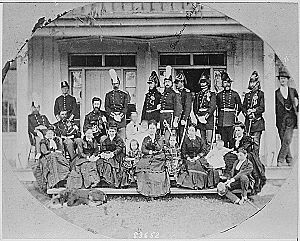Frank Wheaton facts for kids
Quick facts for kids
Frank Wheaton
|
|
|---|---|
 |
|
| Born | May 8, 1833 Providence, Rhode Island |
| Died | June 18, 1903 (aged 70) Washington, D.C. |
| Place of burial | |
| Allegiance | United States of America |
| Service/ |
United States Army |
| Years of service | 1855–1897 |
| Rank | |
| Commands held | 2nd Rhode Island Infantry 2nd U.S. Infantry Regiment |
| Battles/wars | American Civil War Modoc War Garza Revolution Yaqui Uprising |
Frank Wheaton (May 8, 1833 – June 18, 1903) was an important military officer in the United States Army. He served during the American Civil War and in conflicts known as the Indian Wars. He also commanded troops in south Texas during the Garza Revolution.
Contents
Early Life and Military Start
Frank Wheaton was born in Providence, Rhode Island. His father, Dr. Francis Levison Wheaton, was a surgeon who served in wars and for Rhode Island.
Frank went to Brown University to study civil engineering. But at age 17, in 1850, he left to work with the Mexican-American Boundary Commission. He spent five years helping to map the border.
In 1855, he joined the U.S. Army as a first lieutenant. He was sent to the Indian frontier near the Missouri and Kansas borders. He took part in campaigns against the Cheyenne and in the Utah War. He was promoted to captain in 1861.
Wheaton was married three times. His first wife, Sarah Maria Cooper, passed away shortly after their daughter was born. His second wife, Emma Twiggs Mason, also passed away during the Civil War.
Serving in the Civil War
When the American Civil War began, Wheaton joined the Union Army. He became a lieutenant colonel of the 2nd Rhode Island Infantry. It's interesting that his first father-in-law, General Samuel Cooper, was a top general for the Confederacy, while Wheaton fought for the Union.
Wheaton's unit fought in the First Battle of Bull Run. Their commander was killed, and Wheaton took charge. He was promoted to colonel. He led the 2nd Rhode Island during the Peninsula Campaign and was praised for his actions at the Battle of Williamsburg.
In 1862, Wheaton was promoted to brigadier general of volunteers. He led the 3rd Brigade, 3rd Division, VI Corps. His brigade fought hard at the Battle of Chancellorsville.
At the Battle of Gettysburg, his brigade marched about 30 miles in one day. They were the only part of their corps to see action on the second day. Wheaton temporarily commanded the 3rd Division during this major battle.
Wheaton continued to lead his brigade in 1864 during Lt. Gen. Ulysses S. Grant's Overland Campaign. His troops also helped defend Washington, D.C. from a raid by Confederate General Jubal Early.
During the Shenandoah Valley operations, Wheaton was promoted to command the first division. His division fought well in later battles. In the Battle of Sailors Creek, Virginia, in 1865, his division captured Confederate Major General George Washington Custis Lee. This was a big capture, as Lee was the son of General Robert E. Lee.
After the war, Wheaton received an honorary rank of major general in the volunteer army. He also joined a military society for Union officers called the Military Order of the Loyal Legion of the United States.
After the Civil War

For his service in the Civil War, Wheaton received an honorary degree from Brown University in 1865. Rhode Island also gave him a special sword in 1866.
After the war, Wheaton commanded a military district in Nebraska. He was promoted to lieutenant colonel in the regular army. He also received an honorary promotion to major general in the Regular Army for his excellent service during the Civil War.
In 1867, Wheaton married for the third time to Maria Bleeker Miller. She later became a Vice-President General in the Daughters of the American Revolution.
Modoc War and Other Conflicts
Wheaton played a role in the Modoc War in 1873. He commanded about 250 regular army troops and other volunteers. They faced about 50 Modoc warriors in strong positions in the lava fields of Northern California. Wheaton's troops suffered many casualties, while the Modoc had none. Because of this, Wheaton was removed from command in the field.
In 1874, Wheaton became a colonel of the 2nd Infantry. In 1892, he was promoted to brigadier general. This promotion was seen as a good choice because of his strong war record.
In 1896, General Wheaton was involved in the Yaqui Uprising near Ambos Nogales. Some Yaqui, Pima, and Mexican rebels tried to capture a customs house. When they were stopped, some fled north into Arizona. Wheaton sent troops to pursue them, but the rebels escaped. His district also monitored and fought against the Garza Revolution.
Wheaton was promoted to major general in the Regular Army in 1897. He retired one month later on his 64th birthday.
Later Life and Legacy
After retiring from the military, Wheaton spent two years traveling in Europe. He gave a speech in Berlin, Germany, in 1898. In his speech, he encouraged the U.S. Congress to support a stronger military for the country.
Frank Wheaton passed away in Washington, D.C., in 1903. He was buried in Arlington National Cemetery. His third wife, Maria, was buried next to him in 1924.
Several places are named after Frank Wheaton:
- A parking lot near the Tomb of the Unknown Soldier in Arlington National Cemetery.
- The Wheaton, Maryland, area, which is part of Silver Spring, Maryland.
- Wheaton High School in Montgomery County, Maryland.
See also
- List of American Civil War generals (Union)

